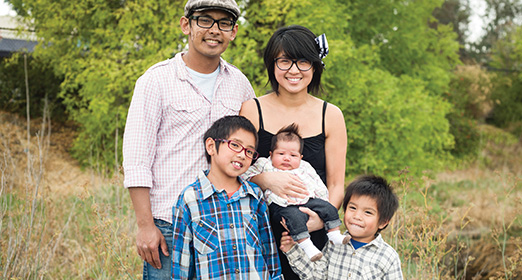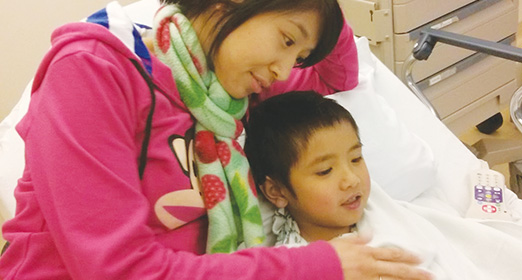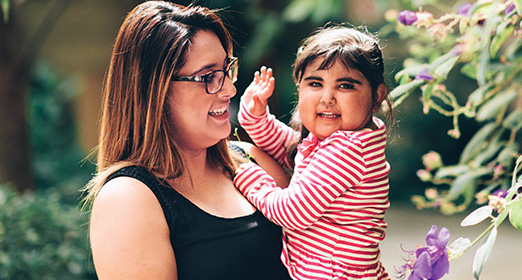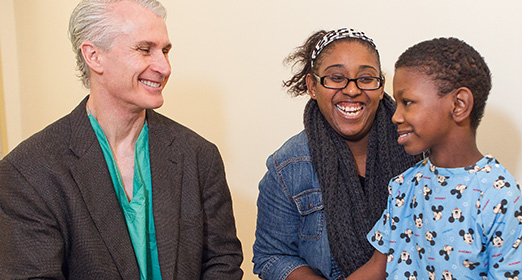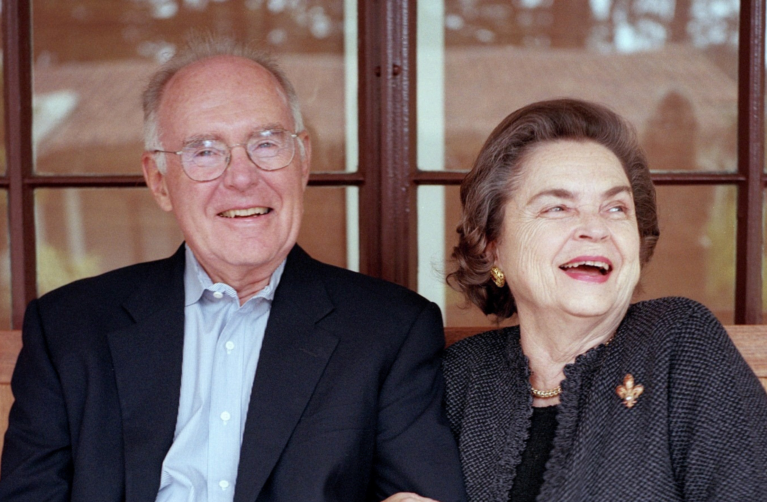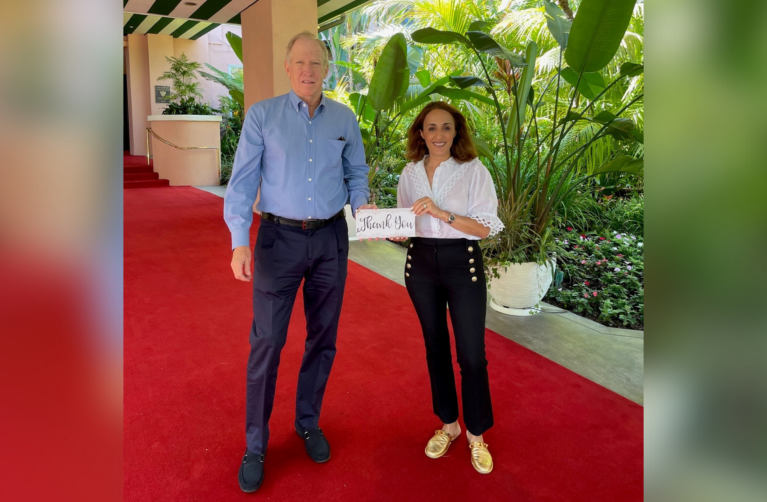Giving birth to her first child was a surreal experience for Tawny Aye—and not the way it is for most mothers.
That evening in February 2007, there were as many as 14 doctors, nurses, and other staff members from Lucile Packard Children’s Hospital Stanford and the Children’s Heart Center in the delivery room with her, waiting for Orion to make his first appearance. As a high-risk baby with a missing pulmonary valve, Orion had only a short time before the situation could become dire. No one was leaving his defective heart to fate. The newborn needed constant monitoring and medication until they could get him into the cardiac operating room.
Luckily, Tawny and her husband, Bo, were well prepared for this moment. When Tawny was 18 weeks pregnant, she went in for a genetic screening test followed by a high-resolution ultrasound which showed Orion had pulmonary atresia with intact ventricular septum. The rare congenital malformation is life-threatening because the valve that lets blood out of the heart to go to the baby’s lungs never fully develops. Tawny’s doctors in Orange County, California said there wasn’t anything they could do until the baby was born. They even seemed a little flummoxed by the grave situation.
“Our original cardiologist didn’t know about these kinds of heart defects and had only seen it in a textbook,” Bo recalls.
The Ayes wanted expert advice so they began researching their son’s heart condition in earnest. After checking out various children’s hospitals that specialized in pediatric cardiology, they chose Lucile Packard Children’s Hospital Stanford. Our Children’s Heart Center, led by executive director Frank Hanley, MD, a renowned cardiothoracic surgeon and luminary in the medical community, and director Stephen Roth, MD, MPH, a nationally recognized cardiac intensivist, is known for caring for some of the sickest and most complex patients anywhere. As a result, our center continuously ranks as one of the nation’s top 15 pediatric heart programs by U.S. News & World Report.
The Ayes were impressed enough to travel across the state.
“We were 200 percent on board with everything the doctors there wanted to do,” Bo recalls. “Whereas our doctors in Orange County said we would just have to wait until Orion was born before addressing his heart issues, the doctors at Stanford wanted to begin observing him immediately.”
That convinced the couple to pack up and move to Mountain View, California, only a 15-minute drive from our hospital.
Within five days of Orion’s birth, our surgeons operated to put in a shunt and patch open the pulmonary outflow so he would have adequate blood flow to his lungs. By the time he was 18 months old, Orion had already undergone four open-heart surgeries to repair his abnormal cardiac structures. His doctors, including pediatric cardiologist David Axelrod, MD, continued to watch him closely.
For children like Orion, our Heart Center’s advanced diagnostic imaging capabilities are a crucial component of their care, notes Frandics Chan, MD, associate professor of radiology. Chan leads a team of nationally recognized experts in cardiac imaging who have brought many new technologies to our hospital—including MRI, CT, radiography, and ultrasound scans — that enhance safety for patients and reveal new information about pediatric heart disease. To obtain detailed information on Orion’s condition, the cardiac imaging team conducted non-invasive MRI scans that provided a three-dimensional image of his moving heart as well as the blood flowing through it.
When Orion was 5 years old, doctors decided to treat a leaky pulmonary valve conduit between his heart’s right pumping chamber and his lungs with an artificial MelodyTM pulmonary valve. This valve can be implanted into the heart using catheters instead of open-heart surgery. Orion had certainly had enough of those.
That’s where Lynn Peng, MD, an interventional cardiologist at the Children’s Heart Center, came in.
“Not everything has to be fixed in an operating room,” Peng notes. “Sometimes we prefer to go with a procedure that is less invasive.”
Peng explained that non-surgical intervention has become a crucial part of the center’s therapies. She successfully implanted Orion’s new MelodyTM valve in the Pediatric Catheterization Laboratory, a procedure room with diagnostic imaging equipment used to visualize a patient’s arteries and heart chambers. A catheter can be inserted into the leg, neck, or shoulder and threaded through veins or arteries to perform everything from a simple diagnosis and biopsy to stenting of blockages and closure of holes in the heart.
Importantly, the recovery process is shorter and easier for patients than it is after surgery. In total, the Children’s Heart Center’s interventional cardiologists now perform 1,100 catheterizations a year, Peng says.
She praises the Children’s Heart Center as one of the most advanced in the nation. “We have some of the most highly trained specialists in the world. We have people who are not only advancing the field but have also pioneered it.”
The day after Orion’s catheterization, Bo shared the happy news on their family’s blog. “The MelodyTM valve was placed successfully and we are ecstatic at the outcome,” he wrote. “Just five years ago, when Orion got his pulmonary valve placed, there was no option but open-heart surgery. Now, after two days in the hospital, Orion already seems back to his goofy self and is about to be sent home.”
For Orion, Lucile Packard Children’s Hospital Stanford has made all the difference in the world to his quality of life, the Ayes say. Since receiving his MelodyTM valve, his mother adds, “He’s awesome. He’s a regular 7-year-old.”
“What we like the most about Packard is its coordination across the board,” Bo says. “The doctors worked in unison, which helped us better understand what was going on with our son.”
A Track Record of Success
Over the years, with investments from the philanthropic community, the Children’s Heart Center has become an integral part of Lucile Packard Children’s Hospital Stanford with more than 250 dedicated faculty and staff representing a broad range of disciplines including cardiology, cardiothoracic surgery, cardiac anesthesiology, radiology, cardiac intensive care, neonatology, nursing, respiratory therapy, and even social work. Everyone works as a team and has in-depth knowledge of each case.
Last year, the center saw 6,600 outpatient visits and performed more than 600 heart operations on-site, plus another 500 with its partner programs throughout Northern California. The team has already performed 25 pediatric heart transplants this year, out of only 500 pediatric heart transplants performed annually worldwide.
Even before the Children’s Heart Center was established, Stanford was renowned for heart transplantation. In 1968, Stanford’s Norman Shumway, MD, performed the nation’s first successful adult heart transplant. Today, the pediatric team continues to build on that rich history of success.
The Children’s Heart Center thrives on the concept of regionalization of pediatric health care, a proven method of delivering the best coordinated and comprehensive care possible to children with complex medical needs. Studies have shown that caregivers are much more specialized and successful when they treat a large volume of complex cases at regional specialty centers like ours—hence our Heart Center’s 98 percent patient survival rate after cardiac surgery.
Furthermore, with partners and clinics throughout Northern California, our Heart Center’s broad network enables patients to receive the same superior care and outcomes as if they came to Stanford, while staying close to home. The Children’s Heart Center is responsible for about 80 percent of pediatric heart surgeries and 100 percent of pediatric heart transplants in Northern California.
As faculty members at Stanford University School of Medicine, our physicians also conduct research on pediatric heart disease which is then translated into innovative patient treatments or preventive techniques. The center is currently participating in 20 clinical research trials and submitted more than 150 papers for publication in peer-reviewed journals just in the past year. Located in the heart of Silicon Valley, our physicians and researchers not only benefit from Stanford University’s advances in science and biotechnology, but from technological innovations as well. And so do our patients.
The Children’s Heart Center has been so successful that it is now planning an expansion that will increase capacity from 20 to 36 beds in the cardiovascular intensive care unit (CVICU), and 20 to 26 beds in the cardiology ward. There will also be six new operating suites in the hospital’s 521,000-square-foot expansion when it opens in 2017, which will provide more access for life-saving heart operations and transplants. In addition, we are creating a state-of-the- art cardiac catheterization lab and expanding our advanced imaging capabilities.
“Expanding our Heart Center means that even more children with complex heart problems, as well as growing numbers of adult survivors of congenital heart disease, will have access to one of America’s most advanced programs,” explains Roth, chief of pediatric cardiology. “Many of these children and adult survivors have run out of options elsewhere.”
Roth, also a professor of pediatrics in cardiology at Stanford University School of Medicine, says there is now more demand for highly specialized treatment for congenital and acquired heart conditions than ever.
“We have a well-deserved reputation for expert teamwork, advanced tools and technology, and one of the most highly qualified and experienced physician and care teams anywhere,” he says.
Chandra Ramamoorthy, MD, who leads a team of 11 cardiac anesthesiologists, seconds that.
“Pediatric heart patients are usually very complex,” she says. “Many have non-cardiac medical problems in addition to their heart disease. They typically have multiple doctors, including pediatricians from wherever they live. We see patients from all over the world, which requires quite a lot of coordination and planning with all the players involved.”
Ramamoorthy says there are weekly meetings where the faculty and staff discuss patient cases and as a group they work together to devise a strategy where everyone is on the same page, including the anesthesiologists who all specialize in caring for children with heart disease. Cardiac anesthesiologists play a crucial role, using medication to safely block pain and keep a child comfortable during operations, diagnostic tests, catheterizations, and other procedures. In the operating room, the anesthesiologists work closely with all members of the team and control vital functions such as blood pressure, temperature, heart function, and oxygen levels in the blood. Every patient is unique and anesthetic management is individualized to provide the best care.
“It’s an expertise,” Ramamoorthy says. “Cardiac anesthesiologists are highly trained and patient safety is our top priority. Not only are we talking about very young people with severe illnesses, but the child’s emotional requirements also need to be addressed. This can include issues such as phobias of being anesthetized. You have to be flexible and have a plan ‘A’ and a plan ‘B.’”
Expertise Required
Karen Vargas’ only plan was to find help for her 3-year-old daughter, Kate Zuno. At age 1, Kate’s health wasn’t right. She suffered from constipation and flu-like symptoms, including trouble breathing. Her local doctors in Ukiah, California thought she had a virus. But Vargas’ inherent mother’s sense told her it was something more. Vargas’ mother agreed, pushing her to take Kate to the emergency room for additional tests.
“This time when I took her, I told the staff that I wasn’t leaving until I found out what was wrong with Kate,” Vargas recalls, convinced that her daughter had asthma.
As it turned out, Kate was diagnosed not with asthma, but with dilated cardiomyopathy, a disease that had caused progressive weakening of the muscle throughout Kate’s heart. The condition required expertise, and doctors at UCSF Benioff Children’s Hospital Oakland, where Vargas eventually took her daughter, thought Lucile Packard Children’s Hospital Stanford was Kate’s best option.
The team at our Children’s Heart Center wanted to get at the root of what was causing the cardiomyopathy and conducted a battery of cardiac, infectious disease, genetic, and metabolic tests. Ultimately, our doctors found that Kate suffered from a rare mitochondrial disorder which displayed most of its symptoms in her heart.
For two years, our doctors treated Kate with medication and monitored her closely. But this past March her health took a turn for the worse. What was believed to be a stomach flu was actually decompensating heart failure. As her condition quickly worsened, Kate was admitted to the CVICU and put on extracorporeal membrane oxygenation—commonly known as ECMO—which provided mechanical support to replace the function of both her heart and lungs.
Her cardiologist, Beth Kaufman, MD, said they had to make difficult decisions regarding long-term therapies. Otherwise, Kate would die. The recommendation was that a heart transplant was her best remedy.
“‘Is she going to get better?’ was my only question,” Vargas says. Satisfied with the answer, Vargas gave the go-ahead to put Kate’s name on the national heart transplant waiting list.
For a couple of months Kate lived in the hospital on a bridge-to-transplant device, called a Berlin Heart, which kept her alive until a donor heart became available. Fortunately for children like Kate, our Heart Center’s Pediatric Advanced Cardiac Therapies program has seen tremendous growth in recent years, and is the only institution in Northern California that offers pediatric advanced heart failure management and cardiac transplantation. Our Heart Center was also among the first to petition the FDA for use of the Berlin Heart in the United States and holds the record for longest pediatric heart-assist in North America with this device, at 234 days.
Luckily, Kate didn’t have to wait that long. Her donor heart came June 20. Kate received the transplant, performed by surgeons Katsuhide Maeda, MD, and Olaf Reinhartz, MD, and the world looks like a different place to Vargas.
“It’s like my daughter is starting a whole new life,” says Vargas, who is back living in Ukiah and beaming with pride as Kate gets steadier on her little feet. “I’m so excited to see her future. She’ll be able to be in sports. She won’t have any limitations. She’ll get to be a normal child, like she deserves.”
The Obvious Choice
Seville Spearman, of DeKalb, Illinois also thanks the Children’s Heart Center for her son’s new life. Two years ago, her son, Jordan Ervin, was diagnosed with Williams syndrome, a chromosomal disorder that affects just one in 10,000 people worldwide. The disease causes severe heart and major blood vessel defects in addition to other maladies. For Jordan, then 5, it was pulmonary artery stenosis, multiple areas of narrowing in the branches of the pulmonary arteries, which caused pulmonary hypertension and made it difficult for the right side of his heart to pump blood into his lungs to pick up oxygen.
The typical treatment involves using a small balloon to expand the artery. But because Jordan had multiple blockages—12 within his left lung and 14 within the right—Seville and her husband, Charles, were told that it would take several procedures and still might not work. Then she heard about pulmonary artery reconstruction surgery and Frank Hanley, who is known throughout the world for performing some of the most complicated pediatric heart surgeries. In fact, Hanley pioneered a procedure called unifocalization, a surgery in which he reconstructs the pulmonary arteries in children who either have no true pulmonary arteries or severely underdeveloped arteries. To Seville and Charles, Hanley and his expertise with pulmonary artery surgery were the obvious choice.
“We just didn’t see a point in multiple ballooning procedures when we could do it all at once—and for good,” Seville says.
Both graduate students, Seville and Charles spent the next couple of months raising the money to come to California and found a short-term rental house for them and their three other children. On December 10, 2014, Hanley reconstructed the main pulmonary artery and its branches in Jordan’s heart in a marathon eight-hour surgery.
“They told us it was risky and we were scared,” Seville recalls. “But the type of support we received from the staff was beyond helpful. It made a difficult situation easier.”
During the surgery, Hanley and his team placed Jordan on life support, separated his right and left lung arteries and then spliced open the main and initial branch arteries, as well as the second- and third-level branch arteries where the 26 blockages were located. Each blockage was either repaired or patched open with human tissues.
As a result of the procedure, Jordan’s pulmonary hypertension was cured, and he headed home to Illinois—right around Christmas—with normal pulmonary artery pressure.
Jordan’s surgery was one of more than 540 pulmonary artery reconstruction surgeries Hanley has performed at Lucile Packard Children’s Hospital Stanford for children with complex pediatric heart defects, and with superior outcomes. Through talent, stamina, and experience, Hanley is able to use this innovative, one-stage approach to decrease overall hospital time for patients, reduce the number of times a heart must be stopped for surgical repairs, and fix problems before they worsen or become impossible to repair.
“We’re definitely on the leading edge of this kind of surgery,’’ says Hanley, who is also the Lawrence Crowley, MD, Professor in Child Health and a professor of cardiothoracic surgery at Stanford University School of Medicine. “Jordan is going to have a perfectly normal life expectancy.”
“Before, I didn’t know if Jordan would make it to his seventh birthday,” Seville says. “It’s nearly a year later, and he can run longer and faster than before the surgery and only occasionally has to use his inhaler. Everything is back to normal and that black cloud hanging over us is gone. Still, our family takes nothing for granted.”
Throughout the Children’s Heart Center, staff members agree that they want every child—like Orion, Kate, and Jordan—to have access to our hospital’s cutting-edge treatments and the chance for a healthier life.
This article first appeared in the Fall 2015 issue of Lucile Packard Children's News.
